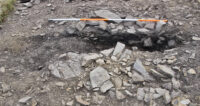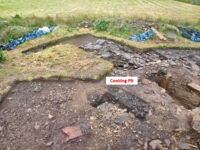 A pit filled with ancient shells at The Cairns site in South Ronaldsay, Orkney, has been radiocarbon dated to the 5th or 6th century. The Iron Age community at the site cooked 18,637 shellfish in the pit, ate them, and then threw the shells back in, all in one massive clambake. That’s more than half of all the shells found at The Cairns, all devoured in a single party.
A pit filled with ancient shells at The Cairns site in South Ronaldsay, Orkney, has been radiocarbon dated to the 5th or 6th century. The Iron Age community at the site cooked 18,637 shellfish in the pit, ate them, and then threw the shells back in, all in one massive clambake. That’s more than half of all the shells found at The Cairns, all devoured in a single party.
The site director at The Cairns is University of the Highlands and Islands Archaeology Institute lecturer Martin Carruthers.
He said: “This is an astonishing number of shells for a short-lived, single-event context. This suggests it may have been part of a special food event, a feast involving the whole community of the site or even beyond.”
The majority of the shells, which were analysed by UHI Archaeology Institute Masters student Holly Young, belonged to limpets (84 per cent), with common periwinkles making up the rest.
The new radiocarbon dating results confirm that the great periwinkle gorge took place at the same time that a souterrain (an underground passageway) next to the pit was in use. It’s possible the association was more than temporal, that souterrains may have played a role in social and religious practices of feasting at the site. A second cache of shells was found on top of the stone slab roof the souterrain.
 The first phase of occupation at the Cairns was in the Neolithic. In the Middle Iron Age (1st century B.C. – late 2nd, early 3rd century A.D.), a broch, a drystone roundhouse, was built, as were other dwellings and enclosure ditches around the settlement. As new structures went up in the settlement, the original broch fell into disuse and was partially built over. When the Iron Age community was throwing its shellfish party, the broch had been infilled. The souterrain was constructed going from outside to inside the former entrance to the broch.
The first phase of occupation at the Cairns was in the Neolithic. In the Middle Iron Age (1st century B.C. – late 2nd, early 3rd century A.D.), a broch, a drystone roundhouse, was built, as were other dwellings and enclosure ditches around the settlement. As new structures went up in the settlement, the original broch fell into disuse and was partially built over. When the Iron Age community was throwing its shellfish party, the broch had been infilled. The souterrain was constructed going from outside to inside the former entrance to the broch.
Archaeologists also discovered whale bones from this period of activity. One bone from a giant fin whale, the second largest species after the blue whale, was carved into a vessel containing a human jawbone. It was positioned at the entrance to the broch next to red deer antlers and a broken quern, and the placement indicates they way they were laid out held symbolic value. More than 100 whale bones have been found from the Iron Age occupation of The Cairns, the largest collection of prehistoric whale bones.